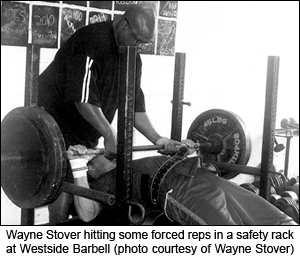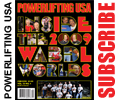STARTIN' OUT
January 2010 - Vol. 33 No. 3
A RETAKE ON FORCED REPS
by Doug Daniels
The forced reps principle of training has probably been used by
99% of all serious lifters and is one of the most popular training
methods in existence. Forced reps can enable a lifter to raise
his training intensity to higher levels,  and hopefully realize
an increase in size and strength. However, even the best practices
can be improved and many lifters stand to gain by re-evaluating
what they are currently doing.
and hopefully realize
an increase in size and strength. However, even the best practices
can be improved and many lifters stand to gain by re-evaluating
what they are currently doing.
Let’s start with a quick explanation of the forced reps principle.
When using forced reps, a lifter completes a rep (or reps) of
an exercise with assistance from a training partner. For example,
you may get 5 reps on the bench by yourself, but on the 6th one,
you get stuck just off the chest. Your training partner would
grab the bar and provide just enough assistance to enable you
to complete the rep. Of course, more reps can be done with increasing
help from your partner. This method enables a lifter to work past
failure, thus adding intensity. The amount of assistance needed
can vary from an ever so slight finger touch at the sticking point
to an all-out effort from every lifter in the gym to get the bar
back in the rack.
Unfortunately, some lifters want too much of a good thing and
push beyond extremes that may not be effective and may very well
prove to be detrimental to their health. Let’s expand further
on the bench press example above. Upon attempting the 6th rep,
the lifter is able to complete the bench rep with just a little
help from his partner, but he continues on for more reps. With
each additional rep, his training partner must lift more and more
of the weight as the lifter’s strength rapidly declines. This
can continue until the assisting partner is lifting almost the
entire weight from an awkward position. This creates a potentially
dangerous situation for both the lifter and his helper. As the
lifter tires, he has less and less control of the bar and could
easily suffer an injury. The partner is also at risk as he must
upright row the bar from an awkward bent forward position, which
could result in a muscle pull or back injury. This could result
in not being able to get the bar back in the rack, which could
spell trouble for both lifter and helper and even lifters nearby.
This could happen at any time so the helper has to be alert and
ready to take full control of the bar at the blink of an eye.
A popular forced reps variation is using a weight over your max
single to exploit negative or eccentric resistance when lowering
the weight. In this example, a 250 lb. max bencher would load
300 lb. on the bar for a forced rep set. His goal in this case
is to lower the bar slowly to get negative resistance and then
try to push the weight off the chest and finish the rep with a
partner’s help. What usually happens in this scenario is the bar
is lowered slowly at first, but as it reaches the mid-point of
its descent, the weight of the bar is too much for the lifter
to lower slowly and it crashes down to his chest. The resulting
press or bounce goes maybe ½ inch up off the chest, dies, and
comes back down. The helper must react quickly and “upright row”
the bar to the rack. In reality, the helper did far more actual
work than the bencher. In my opinion, if the lifter is not lifting
at least 80–90% of the weight, stop the set immediately. Continuing
after this point greatly raises the potential for injury. There’s
a guy at my gym that subscribes to this principle, but most gym
members scatter so as to not be around when he needs help to force
some reps, for obvious reasons.
A better scenario of the above example would be to use less weight,
no more than 100% or perhaps 10% less than max. Using a lower
weight, as I suggest, allows the lifter to focus on lowering the
weight slowly and under control, from the top to the bottom. This
will help develop more power off the chest, in the case of the
bench, instead of essentially working only the top of the lift
when using a heavier weight. If you still feel you must use a
weight over max, I recommend you not add more than 10%. Using
any more weight than this for forced reps increases chance of
injury and compromises the execution and benefits of the set;
not a good idea.
Some lifts are good fits for forced reps like benches, overhead
presses, chins and pulldowns. Other lifts like the squat and deadlift
just don’t fit the scheme due to their complexity and inherent
danger. Use common sense to determine what lifts you can apply
forced reps to. Don’t “force” a lift into a forced reps mode.
Use of a power rack can add a great deal of safety as the pins
can be set to catch the bar if the lifter or helpers fail to lift
or control the weight.
Finally, because of the high intensity involved with forced reps,
limit their use to not overstress your recuperative abilities.
Recuperative ability varies from individual to individual. Some
lifters might be able to push the level of intensity harder and
longer than others before they overtrain. One or two sets per
exercise using forced reps is more than adequate. I suggest dropping
forced reps training 2 weeks prior a contest to avoid being overtrained
on meet day.
If you are not getting results from forced reps, do a re-think
on your current practices versus my suggestions. When you feel
yourself not lifting at least 80–90% of the weight during a forced
rep, stop the set. Your safety and the safety of your helpers
and other gym members should be foremost on your mind. If fellow
gym members scatter when you come to bench, do a retake on forced
reps.


